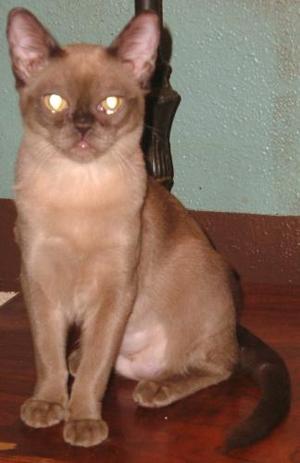In the world of cat rescue we have intaked some wonderful felines. Some we have not wanted to part with, because we, ourselves, fell in love. The Burmese we have been blessed enough to rescue fit into this category. Alas, we did adopt them out to wonderful forever homes, because we know we simply cannot keep them all. To adopt them all the ones we fall in love with would defeat the point of rescue.
Ten interesting facts about the Burmese Breed #1)
This breed is split into two sub categories. Huh? I know, but they are. The American Burmese and the British Burmese. Due to mixed gene pools, the British Burmese are more Oriental in their physicality and the American Burmese are stockier in their build. While first recognized as a breed in 1936, due to cross breeding with Siamese, soon the breed became “overextended” and was no longer accepted as a reputable breed until 1953. The love and demand for this wonderful breed of feline, did not go quietly into the good night, thus the breed once again gained acceptance with the Cat Fanciers Association.
Ten interesting facts about the Burmese Breed #2)
Burmese, normally, have amber or green colored eyes. However, with all the Siamese crossbreeding, blue eyed Burmese have been known to be born. Typical colors of Burmese are Sable, Champagne, Blue and Platinum.
Ten interesting facts about the Burmese Breed #3)
Dr. Joseph Thompson of San Francisco came by a beautiful walnut brown female cat from Burma, Wong Mau. Through selective breeding with Siamese, the Burmese soon became a distinct breed of themselves.
Ten interesting facts about the Burmese Breed #4)
Burmese are stronger and more solid than they appear. They may be short silky haired, but they are strong and nimble. These cats are jumpers. One of the Burmese we rescued was a kitten we nicknamed monkey. Aptly nicknamed, because she was everywhere. She was the first to jump to the top of our living room armoire.
Ten interesting facts about the Burmese Breed #5)
Burmese, like Persians have big round eyes that are quite expressive. Their eyes can have you from the first look. Looking to be owned? Looking to fall in love? Look into the eyes of a Burmese. You will be a goner.
Ten interesting facts about the Burmese Breed #6)
Burmese kittens are of a rambunctious sort. Though it may appear that they are clumsy, they are not. They are landing on their round rumps just fine and already contemplating their next jump. Are you looking for a friendly outgoing cat, look no further.
Ten interesting facts about the Burmese Breed #7)
Most kittens show their personalities by the age of two months, with Burmese; their personalities do not begin to form until later, as their intelligence increases with age.
Ten interesting facts about the Burmese Breed #8)
Siamese can be talkers. Siamese can be stalkers. Burmese, though similar to the Siamese, are not as vocal. To be precise and nothing against Siamese here at all, but the Burmese meow is much more melodious than that of the high pitched Siamese.
Ten interesting facts about the Burmese Breed #9)
Burmese are people orientated and love to be around their people. They are great with children and love to help you to read. Unlike Persians, Burmese are lap kitties.
Ten interesting facts about the Burmese Breed #10)
Burmese have no survival instinct. No going outside for these fur babies!!!! Their idea of survival is to find you. After all you are their staff. Burmese enjoy sampling fruits and vegetables.
Ten interesting facts about the Burmese Breed #11) – because an extra fact is good for you.
The Burmese breed can trace its origins back to Siam. There are poems from Thailand (then known as Siam) about three breeds of cats: the Vichien Mat (Siamese), the Si Sawat (the Korat) and the Thong Daeng (the Burmese). When Siam was invaded by Burmese soldiers in the 18th century, the cats were brought back to Burma by returning soldiers.



